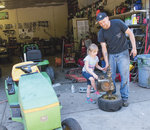


As the backyard is awakening from its winter slumber, flowers are blooming and trees are sporting a fresh new canopy of leaves. The carpet of grass which sat idle begins to grow vigorously, and the accompanying symphony of lawnmowers begins, up and down any neighborhood street.
Few lawn tools take a beating like the lawnmower, but it often doesn’t get any attention until it breaks or won’t start. Doing routine maintenance at the beginning of the “mowing season” will set you up for a trouble free summer in the yard. And, simple maintenance routines will prolong the life and improve the performance of your mower.
Kyle Thorson, owner of Kyle’s Starter and Mower’s in Battle Ground, sees this on a daily basis, when his shop fills up in the spring with mowers and lawn equipment which are brought out of the garden shed and won’t start.
Thorson recommends a maintenance routine for lawnmowers in the spring and fall to keep them running their best.
Change the oil. Any proper weight motor oil will work.
Install new spark plugs.
Install new air filters.
Sharpen, and balance, the blades. Unbalanced mower blades cause vibration to the motor which can lead to failing seals and oil leaks.
Clean the underside of the deck to remove grass. This prevents rust on the mower deck, and improves the mower’s cut.
Drain or replace the fuel.
The most common problem Thorson sees is mowers which sat idle all winter with a tank full of regular ethanol-added gas. The ethanol draws condensation into the fuel system of the mower, and it won’t start or runs rough.
Thorson tried an experiment to see just how much water is drawn into ethanol-added gas. He placed two Mason-type jars side by side, one with ethanol free gas and one with ethanol-added gas, and both lids slightly loose. After one week, the jar with ethanol-added gas had drawn one inch of water into the jar. He uses this illustration to explain to customers how their mower ended up with water in the fuel tank.
Ideally it’s better to use gas without any ethanol in your mower. In fact, the Environmental Protection Agency prohibits the use of gasoline with 15 percent ethanol in mowers and other power equipment, stating it may cause damage. Ethanol will clog the equipment’s carburetor, leading to repairs or even replacement.
Even gas with the usual 10 percent ethanol (E10) could help destroy small engines. In a Consumer Reports statement, Marv Klowak, global vice president of research and development for Briggs & Stratton, said "Ethanol has inherent properties that can cause corrosion of metal parts, including carburetors, degradation of plastic and rubber components, harder starting, and reduced engine life.”
There are two schools of thought on the best way to winterize a lawnmower, says Thorson. When all the fuel is drained, the seals in the carburetor can dry out. But, ethanol-added fuel left in the mower does its own damage. Thorson recommends running a final tank of ethanol free fuel through the mower before letting it sit for the winter.
That ethanol-added gas you have left sitting in cans? It won’t be any good next year; it starts to “go bad” in just a month, says Thorson. But you don’t have to throw it out; your car will run on it just fine.
A few jobs are best done with every mowing. Check the oil in the mower, and clean the sticky grass from the underside of the deck. The most important thing about maintenance, with all your lawn equipment, is that it prevents big jobs down the road.
A few stations sell ethanol free gas in Clark County. A list is available online at www.pure-gas.org.